If you’ve read many articles here on this website you’ll know that we generally prefer to slow travel, explore in our own time and frequently make happy discoveries while we are lost. We prefer to learn as we go rather than join tours.
In recent years we have made an exception for food tours across Japan. While I still research and hunt down dozens of small restaurants and food stalls to try during our trips we’ve also started including a few carefully selected food tours on the itinerary.
If you are planning to spend some time in Asakusa while you’re in Tokyo? Don’t miss all the details and suggestions in our popular Asakusa guide.
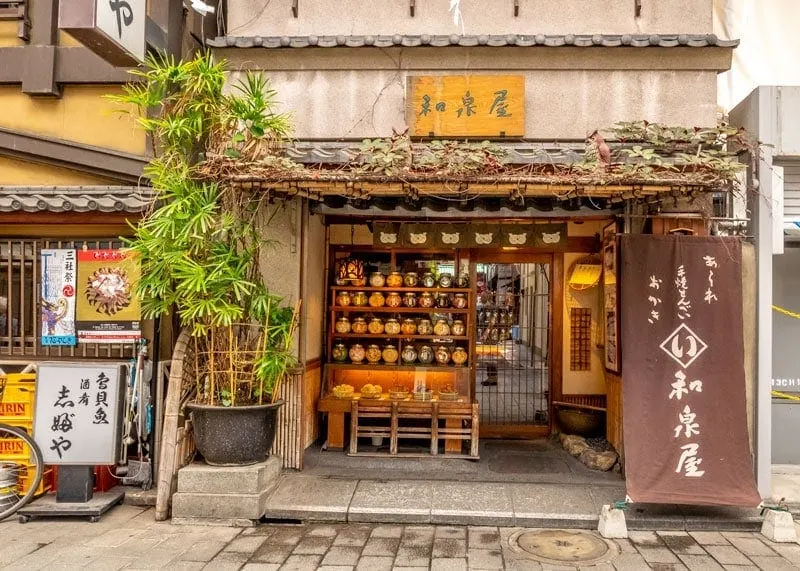
This Asakusa food tour was one of the first ones we did. The idea is that we learn a bit more about the food culture and regional specialties but also we almost always add a list of new places to try over the coming days. These come from the guide’s recommendations and in discovering new buildings or streets of restaurants, even in areas we know quite well. To make the best use of this knowledge it is a good idea to plan to do your food tour in your first few days in the city.
We did the Asakusa food tour with Asami who is incredible as a guide, her energy and enthusiasm are contagious but we have enjoyed all the tours we have done with the Arigato Japan team. If you take the same tour, you may have a different guide and visit different stops as the itinerary changes depending on the day, the group and the guide. Here we intend to give you a good idea of what to expect from the tour by taking you along with us while avoiding spoilers as much as possible.
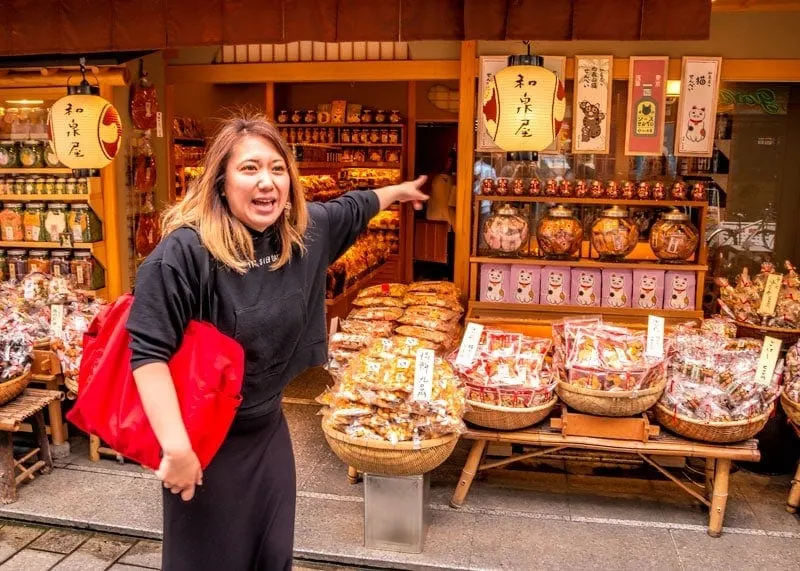
The meeting point is in front of the Cultural Centre which is very close to Asakusa station, it is the arrival point for most visitors to the area and is located directly opposite the very famous Kaminarimon Gate.
Book the Asakusa Food Tour with Arigato Travel
It would be impossible to get lost getting to this one being such a key destination in Tokyo but the instructions are excellent and Asami did a good job of picking out people who look like they might be hovering around with a purpose.
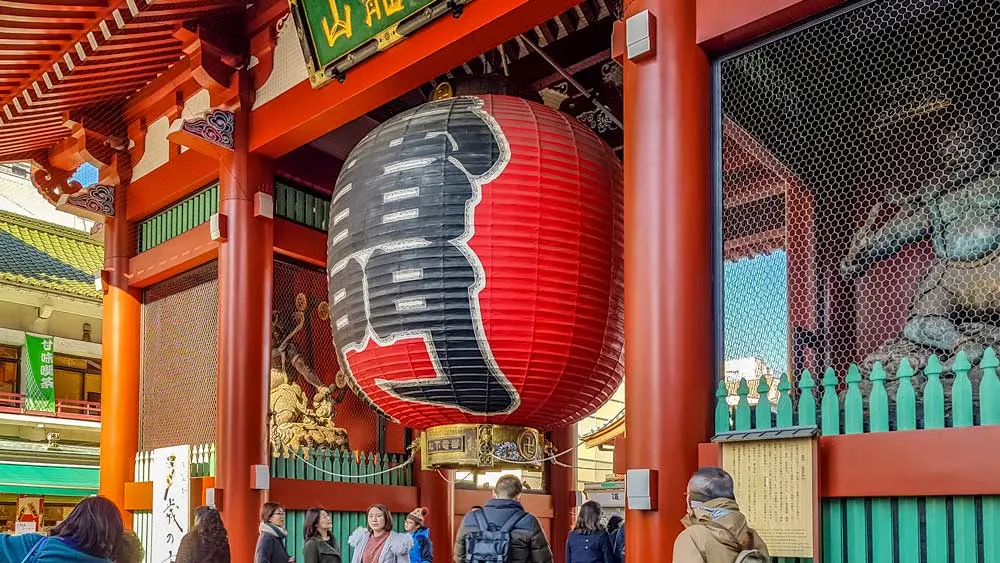
We were a small group on this tour, just the two of us, another couple from Europe and our local guide which was perfect, it quickly felt like we’d met up with a group of friends for lunch rather than being a typical tour experience.
This would also be a great family food tour. Exploring in the day is generally easier with children and the street food snack options on this tour appeal to a wide range of food preferences, you eat often while walking around so little legs don’t need to walk far without a stop and when ordering the main lunch selection all food preferences and how adventurous the group as a whole wants to be is taken into account, it’s not a fixed menu.
We all headed inside the cultural centre and up to the viewing deck on the top floor for initial introductions and an overview of the afternoon’s agenda. This Asakusa viewing deck isn’t a secret spot at all being part of the cultural and information centre but at the time it wasn’t that well known either, we’d only fairly recently heard about it while chatting with a friend on our Instagram page.
Asakusa is an older city and is sometimes called the low city with many of the older buildings around the famous shopping street and temple being dwarfed by by the Sensoji Temple pagoda and other buildings. This perspective on Asakusa from up high is well worth getting, it will help you visualise better where you are in the maze of narrow laneways as you wander through them later.
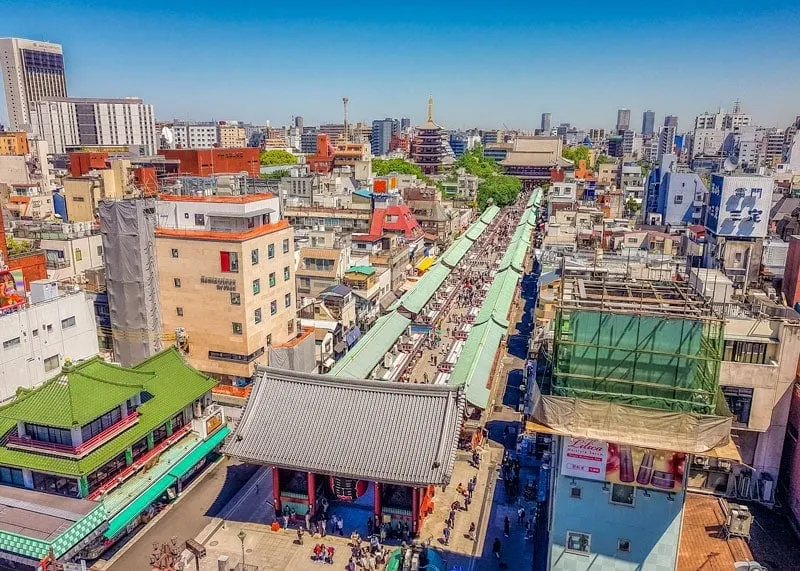
Asami is Japanese but has previously lived in the US for 10 years so she has the advantage of speaking perfect English but also having that deep understanding of the country and culture that only comes with someone who grew up in it. She’s also a foodie who appreciates that the right pairing of food, drink and friends creates lifelong memories. A woman I can relate to and I immediately know this is going to be a fabulous afternoon.
We head off across the road but instead of following the typical path we have many times before beneath the gate and along the Nakemise shopping street we detour slightly and find ourselves on narrower and much quieter laneways. Our first stop is for fresh Senbei. If you thought rice crackers were those bland things many of us keep in our desk drawers for when we need a snack and don’t have the time to get to lunch then this store will change your perception of this crunchy tasty snack.
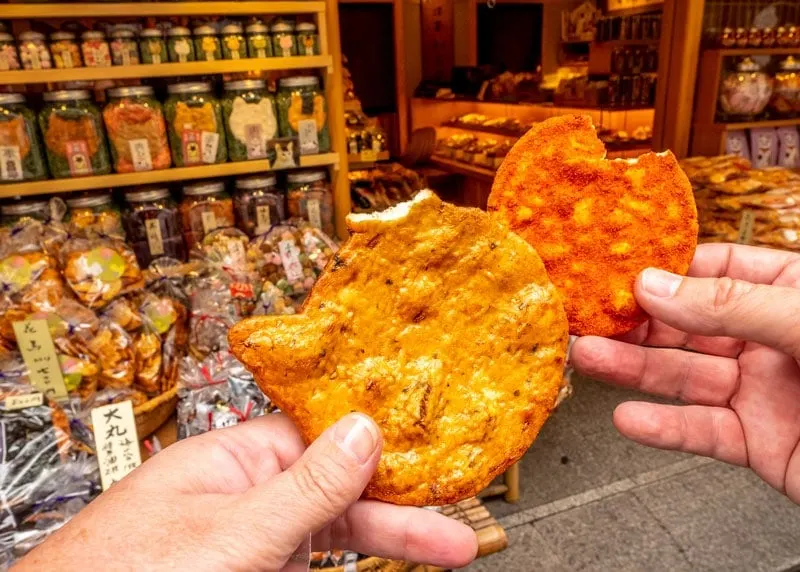
Continuing on we pop into a Japanese pickles store and I could happily spend the rest of the afternoon sampling in here. I just wish I could take some of these home with me or even better find a Japanese pickling class in English. There are so many variations and vegetables I’ve not seen before including some incredibly delicious wood-ear mushrooms called Kikurage that are generally served on rice but I could happily stand here and feast on for hours.
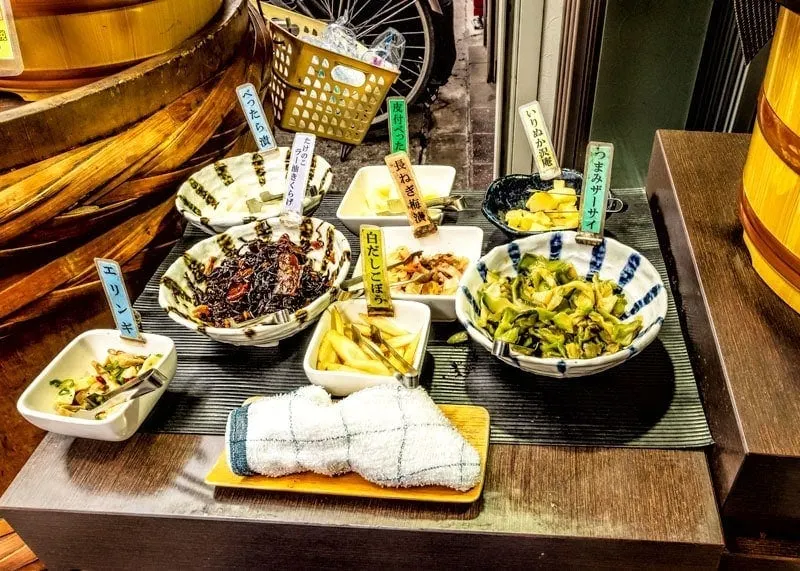
From here we head on through more of the market area. It was children’s day the week we visited and we picked up a few tips on using gifting envelopes. We also learn why those Zen Daruma dolls have no eyes when you see them for sale and other tidbits including the history of those little noren curtains that hang in the doorways of many traditional restaurants.
Our next tasting destination isn’t much more than a window but there’s a decent size queue for their popular Menjikatsu. They’re made with minced pork and caramelised onion that are formed into a patty, breaded on the outside and fried until hot and crunchy but still succulent inside.
Asami tells us you can find these all around the city but these are her personal favourites and from the constant stream of customers she is not alone. I think I’m still a fan of the plain karokke (potato croquette) but Drew prefers these.
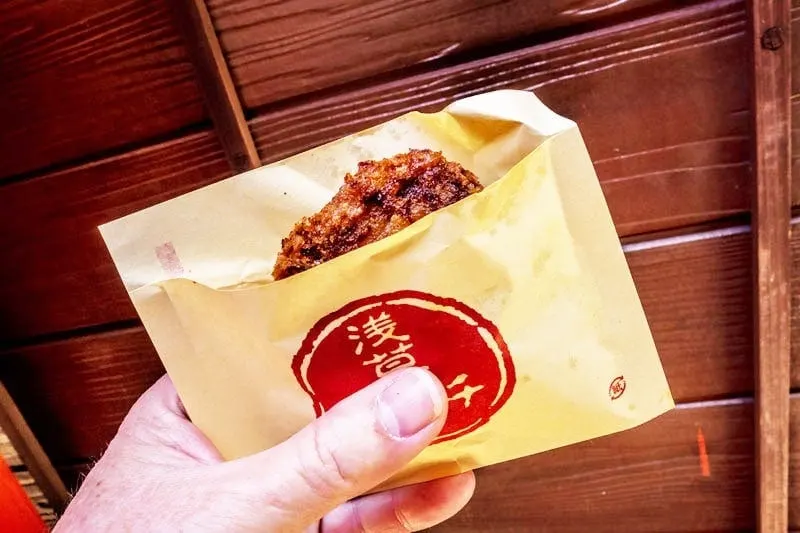
As we headed into Hoppy Street we could no longer claim to be hungry but were still looking forward to seeing what lunch might involve. The guides take into account the dietary requirements and preferences of their guests but as we had all made it clear we were open to trying the diversity of Tokyo’s food scene we gave Asami free rein to choose for us on the proviso we get some sashimi fresh from the Tokyo fish markets.
Lunch is at a casual izakaya which I believe translates to something like ‘stop a while and have a drink’ although from what we saw across Japan invariably the izakaya also offers some form of food. Some like this one have a wide range of options to choose from. Others are more limited.
Some of the options in our selection are tuna and mackerel sashimi, mentaiko cod roe, beef tendon prepared with sake and mirin, and squid gut which although it’s as slimy as it sounds is also inexplicably good. This is chased by our drinks of choice. By this point in the trip I’ve become a fan of the chūhai, a long drink with a spirit base and a fruit flavour, today’s is grapefruit and I like that it’s not too sweet. Others in the group select local beers and sake.
Just a quick note that if you prefer not to push the dietary boundaries as far or you are thinking of doing the tour with children then the food at lunch is ordered to suit your particular group. There are plenty of options available, we did all challenge Asami to surprise us, and she lived up to that.
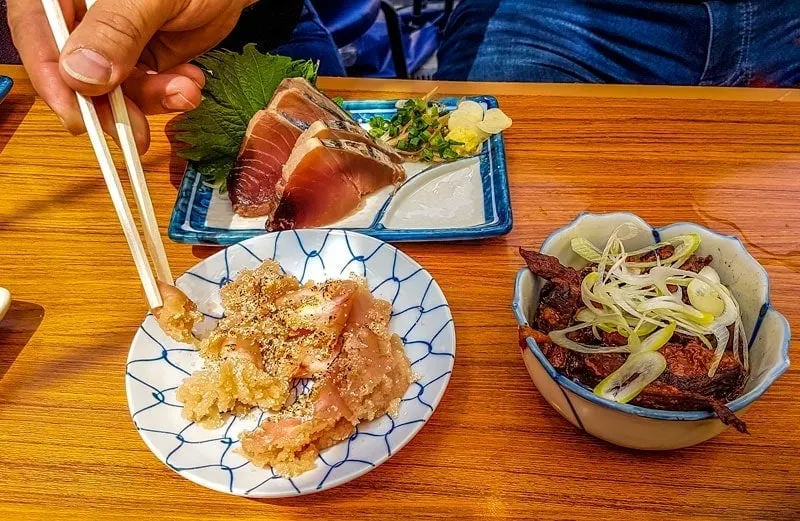
The afternoon of eating is broken up by a visit to Sensoji temple where we get our fortune told by the omikuji sticks, mine is good luck so I tuck it away in my bag, those who are less fortunate tie it off to the frame so the bad luck doesn’t follow them home.
We learn a bit about the temple, gotcha-pong and the ever-present vending machines as we wander the streets around Asakusa. Our guide was happy to answer any and every question we came up with but also explained things we saw along the way which really made the afternoon interesting and despite being familiar with the area I felt I was also seeing it with fresh eyes.
Did you know there is a Hollywood-style street of stars in Asakusa? Or tiny tanuki (Japanese badger) shrines for pretty much anything you can think of? I didn’t. We also learned about ‘antenna stores’ which were a new concept to me but exist all across Japan.
You’ll find antenna stores mostly in big cities like Tokyo because people move here to work from all across the country. They are a way for those living nearby to get a taste of their home prefectures food specialties but as a tourist, they are also a very interesting concept.
We visited one in Asakusa and tried a delicious mugwort mochi with a red bean paste inside that was wrapped in bamboo leaf. In the next stall, we discovered another new treat, Warabi mochi with black sesame and matcha. Both were so good! A sweet but not too sweet treat to round out our lunch.
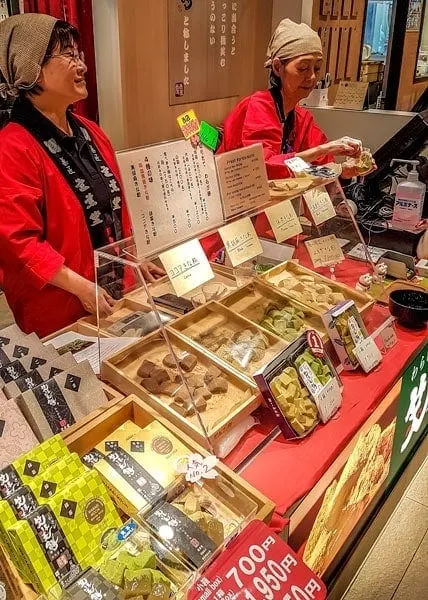
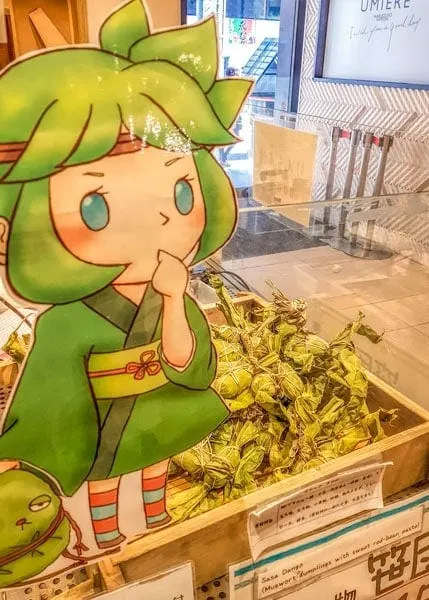
It didn’t end there though, for our final stop on the tour, we headed into a covered arcade to visit a super popular melon pan bakery. They have been in operation since 1945 and sell over 3000 of these sweet bread rolls every day.
Judging by the mid-afternoon crowd, it feels as if everyone has heard of this shop front but our guide is in the know and we quietly head upstairs and remove our shoes to enter their tatami matted seating area. We have the room entirely to ourselves. I ordered a cup of matcha, a slightly bitter Japanese green tea to go along with my sweet treat.
The melon pan here is crunchy on the outside but light as air in the middle. It doesn’t taste of melon, that just refers to the grid pattern on the top but these are quite different to similar-looking bread we have tried before.
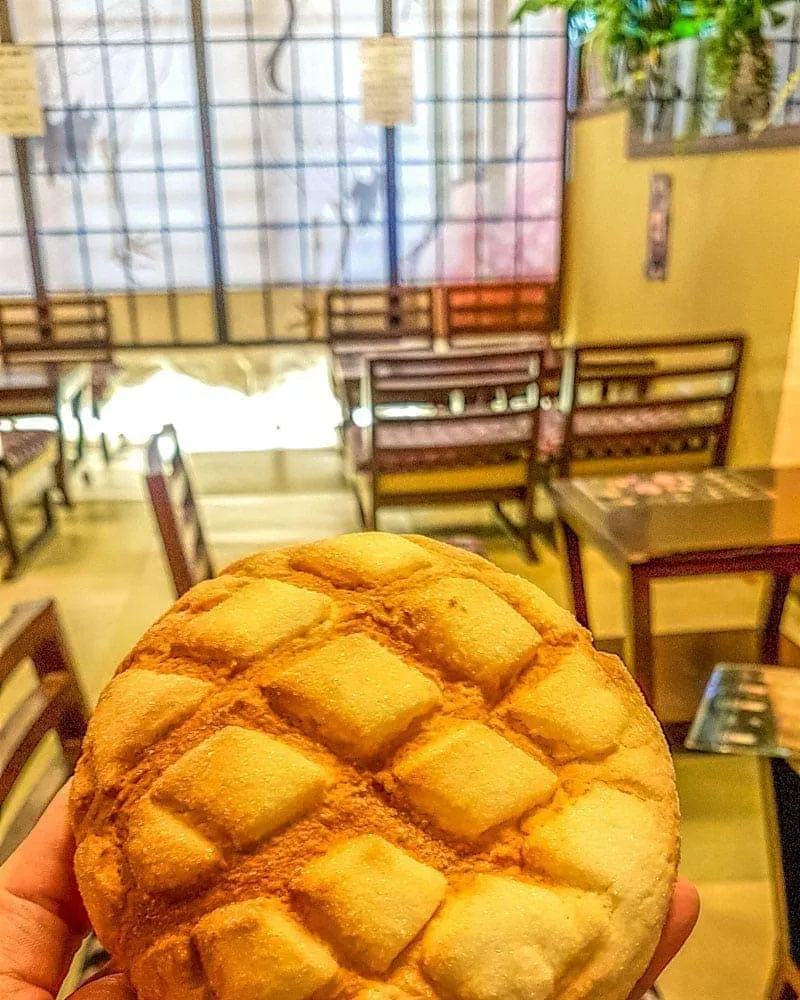
We fully expected the tour to end here, we had eaten a lot by this point but our guide still had a couple of surprises left in store for us. As we headed towards Sensoji we stopped in at Lawson’s to try her current treat of choice, which happened to be a far easier-to-find and budget version of one of my all-time favourite sweet treats in Japan. We wound up the tour getting our fortune told at one of Tokyo’s most famous temples.
All up we found the Asakasa daytime food tour to be a great experience. I’d give Asami our guide, the quantity, quality and variety of food top marks. Arigato Travel Tours are a bit more expensive than some of their competitors but having done a few now with different companies now we do feel that difference is well represented in the food, drinks and the overall experience.
Sara
Tuesday 20th of February 2024
Wow! My family and I have been there, we have enjoyed it so much! very good information.